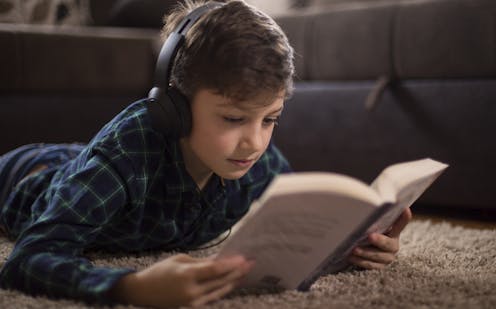Do you really need to read to learn? What neuroscience says about reading versus listening
- Written by Stephanie N. Del Tufo, Assistant Professor of Education & Human Development, University of Delaware

Different brain processes
Your brain uses some of the same language and cognitive systems[7] for both reading and listening, but it also performs different functions[8] depending on how you’re taking in the information.
When you read, your brain is working hard behind the scenes[9]. It recognizes the shapes of letters, matches them to speech sounds, connects those sounds to meaning, then links those meanings across words, sentences and even whole books. The text uses visual structure such as punctuation marks, paragraph breaks or bolded words to guide understanding. You can go at your own speed.
Listening, on the other hand, requires your brain to work at the pace of the speaker. Because spoken language is fleeting, listeners must rely on cognitive processes, including memory[10] to hold onto what they just heard.
Speech is also a continuous stream, not neatly separated words. When someone speaks, the sounds blend together in a process called coarticulation[11]. This requires the listener’s brain to quickly identify word boundaries and connect sounds to meanings[12]. Beyond identifying the words themselves, the listener’s brain must also pay attention to tone, speaker identity and context to understand the speaker’s meaning.
‘Easier’ is relative – and contextual
Many people assume that listening is easier than reading, but this is not usually the case. Research shows that listening can be harder than reading[13], especially when the material is complex or unfamiliar.
Listening and reading comprehension are more similar for simple narratives, like fictional stories, than for nonfiction books or essays that explain facts, ideas or how things work. My research shows that genre affects how you read. In fact, different kinds of texts rely on specialized brain networks[14]. Fictional stories engage regions of the brain involved in social understanding and storytelling[15]. Nonfiction texts, on the other hand, rely on a brain network[16] that helps with strategic thinking and goal-directed attention[17].
Reading difficult material tends to be easier than listening from a practical standpoint, as well. Reading lets you move around within the text easily, rereading particular sections if you’re struggling to understand, or underlining important points to revisit later. A listener who is having trouble following a particular point must pause and rewind, which is less precise than scanning a page and can interrupt the flow of listening, impeding understanding.
Even so, for some people, like those with developmental dyslexia[18], listening may be easier. Individuals with developmental dyslexia often struggle to apply their knowledge of written language to correctly pronounce written words, a process known as decoding[19]. Listening allows the brain to extract meaning without the difficult process of decoding.
Engaging with the material
One last thing to consider is engagement[20]. In this context, engagement refers to being mentally present, actively focusing, processing information and connecting ideas[21] to what you already know.
People often listen while doing other things, like exercising, cooking or browsing the internet – activities that would be hard to do while reading. When researchers asked college students to either read or listen to a podcast on their own time, students who read the material performed significantly better on a quiz[22] than those who listened. Many of the students who listened reported multitasking, such as clicking around on their computers while the podcast played. This is particularly important, as paying attention appears to be more important for listening comprehension than reading comprehension[23].
So, yes, reading still matters, even when listening is an option. Each activity offers something different, and they are not interchangeable.
The best way to learn is not by treating books and audio recordings as the same, but by knowing how each works and using both to better understand the world.
Hello, curious kids! Do you have a question you’d like an expert to answer? Ask an adult to send your question to CuriousKidsUS@theconversation.com[24]. Please tell us your name, age and the city where you live.
And since curiosity has no age limit – adults, let us know what you’re wondering, too. We won’t be able to answer every question, but we will do our best.
References
- ^ Curious Kids (theconversation.com)
- ^ CuriousKidsUS@theconversation.com (theconversation.com)
- ^ language scientist (scholar.google.com)
- ^ MRI (www.mayoclinic.org)
- ^ EEG (www.mayoclinic.org)
- ^ Rajaaisya/Science Photo Library via Getty Images (www.gettyimages.com)
- ^ cognitive systems (doi.org)
- ^ performs different functions (doi.org)
- ^ your brain is working hard behind the scenes (youtu.be)
- ^ listeners must rely on cognitive processes, including memory (doi.org)
- ^ blend together in a process called coarticulation (doi.org)
- ^ sounds to meanings (www.nature.com)
- ^ listening can be harder than reading (doi.org)
- ^ rely on specialized brain networks (doi.org)
- ^ social understanding and storytelling (doi.org)
- ^ rely on a brain network (doi.org)
- ^ strategic thinking and goal-directed attention (doi.org)
- ^ developmental dyslexia (doi.org)
- ^ process known as decoding (www.doe.mass.edu)
- ^ engagement (doi.org)
- ^ mentally present, actively focusing, processing information and connecting ideas (doi.org)
- ^ performed significantly better on a quiz (doi.org)
- ^ listening comprehension than reading comprehension (doi.org)
- ^ CuriousKidsUS@theconversation.com (theconversation.com)
Authors: Stephanie N. Del Tufo, Assistant Professor of Education & Human Development, University of Delaware

